In this article, you’ll learn what is Punch tool? and the different types of punches. How they are used in the workshop? explained in detail. Also, download the PDF file of this article at the end.
What is Punch Tool?
After you are done drawing marking lines on a job by scriber or surface gauge, you need different types of punches to make these markings permanent, because there is the possibility of the lines marked with a scriber getting destroyed.
In various industries, they have been using different types of punches in their workshops for a long time. Commonly, a punch is a rigid metal rod with a pointed tip at one end and a dull end at the other.
These punches are generally made of carbon steel or tool steel. They are used in combination with tools like a hammer and chisel to make them properly cut and shaped.
Typically, punches are available according to the shape of the point. If you are seeking a type of punch for your work, here are some types of punches and their expected use.
Read Also: Different Types of Essential Electrician Tools [Names & Uses]
Classification of Punch Tool
Punching holes or cutting shapes into materials like paper, leather, or metal is done with the help of punching tools. Their size, shape, and intended use can all be used to categorize them. Here are some typical groups that punch tools fall under:
#1 According to the Shape & Size
Punches are typically categorized based on the shape and size of their points. The prick punch is the most widely used and is very useful for marking reference points on metal sheets. The dimensions from a paper pattern are directly transferred to the metal using these punches.
You must place the paper pattern directly on the metal and in the direction you need to get the results in order to take the reference correctly.
#2 According to the Slider Movement
Punches are also categorized according to how the slider moves. These are further broken down into 3 categories. There are three types of punches: single action, double action, and three actions, but single action punches are the most popular.
Read Also: 26 Different Types of Welding Tools and Equipments [Complete Guide]
Types of Punch Tools
Types of punches are as follows:
- Centre punch
- Prick punch
- Solid punch
- Transfer punch
- Drive punch
- Marking punch
- Pin punch
- Roll pin punch
- Ejector pin punch
- Straight punch
- Pilot punch
- Hollow punch
- Dot punch
- Bell punch
- Letter stamps
- Tablet punch
- Automatic punch
#1 Centre Punch

These are made of high carbon steel. These are made hard and given temper treatment. Their point is made at a 90° angle and the handling part is knurled. Its length is from 35 mm to 125 mm and its width is from 4 to 12 mm.
Their use is generally made to make a centre at the drilling point so that the drill bit’s point can rest there properly. If this centre is not made by the centre punch, there are chances of slipping of the point and drilling at the wrong point. This type of centre has been illustrated in Figure.
#2 Prick Punch

This is also made of high carbon steel, prick punch is also made hard and tempered. Its point is made at a 30° angle. It is used for marking on jobs of thin metal sheets or to make holes in them. It has been shown in Figure.
#3 Solid Punch
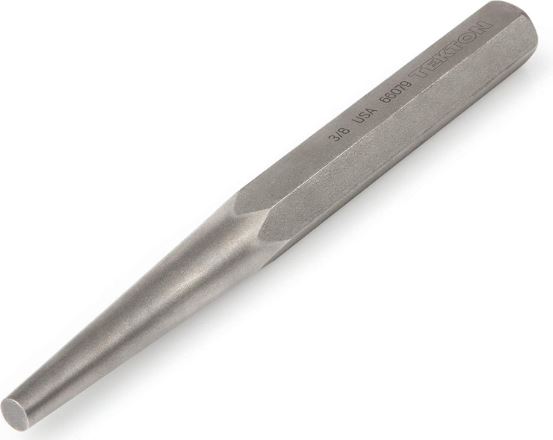
Solid punch is used for boring holes in blacksmithy and sheet metal operations. These are used in different measurements according to the jobs. These are produced of high carbon steel, hardened, and tempered.
While using these in hot jobs it is essential to cool them in cold water. These are used in rough works because holes made with a solid punch are not exactly according to measurements and are not clean.
#4 Transfer Punch
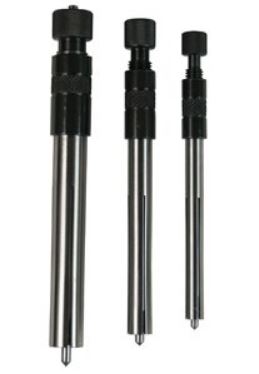
The standard length of such a punch is 4 inches, which is sufficient to move the location of the hole through a pattern or template on the material. A transfer punch is of a specific outer diameter that is non-tapered.
Using the transfer punch, you can tight the tolerance of an actual hole and, when struck, it suitably transfers the center of that hole to another surface. This can also be used to fit the drilling and tapping holes in a template to bolt an object to a surface.
Read Also: What Are The Different Types of Fasteners? Their Uses & Examples
#5 Drive Punch
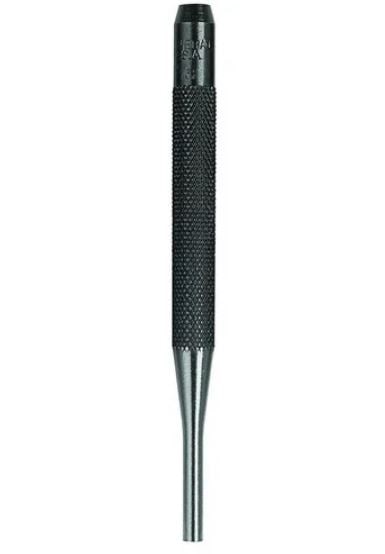
You should use a drive punch if you want to remove damaged rivets, bolts, and pins that are tied into the holes. Rather than pointed ends, a drive punch is made of a flat face.
And the sides of this punch will taper the face. In some conditions, you have to use a punch with a straight shank. A straight shank punch is more likely known as a pin or drift punch.
#6 Marking Punch
The marking punches are defined as those punches that are used to emboss or to create a certain texture on the surface of a material or a piece of work, such as a printing surface.
#7 Pin Punch
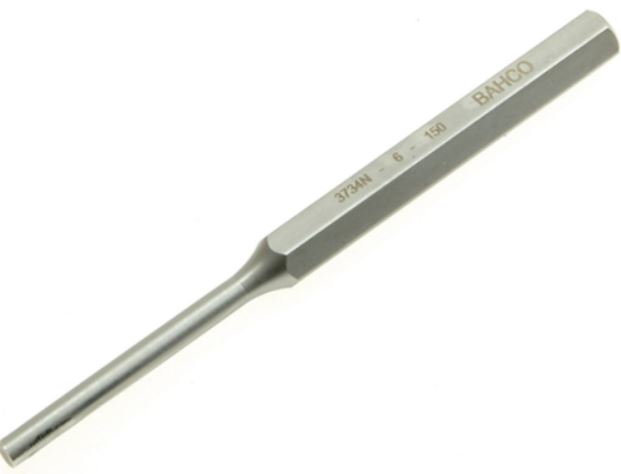
These types of punches are somewhat different from other punches. It is comparatively larger in length. Instead of being pointed in shape, these are parallel. It is used for tight-fitting pins.
Pin punches can fully turn the rivets and pins out of a hole until they exit the hole, which cannot be done by the other punches. A pin punch has been shown in Figure.
#8 Roll Pin Punch
The roll pin punch is made with a small projection in the center of the pin tip to hold the periphery of the roll pin. The tips of these types of punches are not flat and are used to drive roll pins. It is also known for spring punches.
While using a roll pin punch, ensure that the shank axis of the roll pin punch is consistent with the axis of the roll pin. Do not close the roll pin punch with one side. Whenever you hit a roll pin punch, hit it right on top of its head, or it may bend the shank.
Read Also: List of 25 Types of Plumbing Tools [Names & Pictures] Explained
#9 Ejector Pin Punch
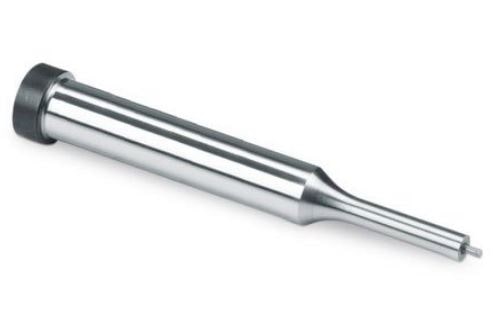
As the name suggests, ejector punches are those mechanical devices used for removing material after it has been pressed or stamped out. They are commonly used to eject parts after they have been pressed out. This punch is made of a rigid metal that resembles a pen.
#10 Straight Punch
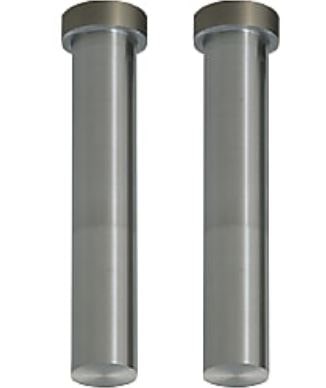
Generally, straight punches refer to those mechanical devices that are used to cut through metal sheets or other material sheet sheets, such as leather or plastic, to give an even surface. These types of punches are available in numerous leather and plastic industries and are quite easy to use.
#11 Pilot Punch

One of the common characteristics of pilot punches is that they have an inner pin that is able to be aligned into an existing hole or can also be allowed to cut a bigger hole with the outer point. These punches resemble solid punches, which have a solid flat point without any voids or internal bores, or regular punches.
#12 Hollow Punch
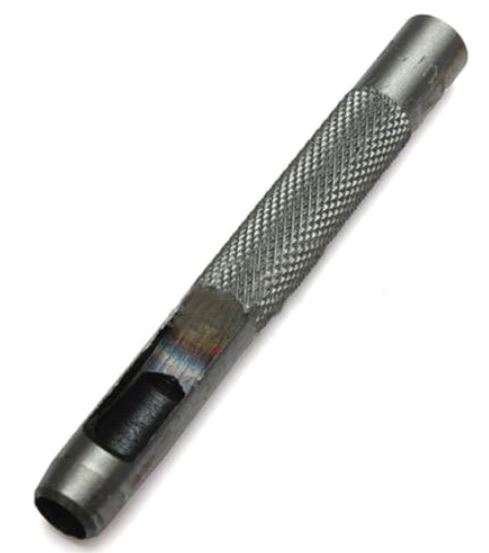
It is a special type of a hardened steel punch with hollowness as shown in Figure. It is used for cutting holes in metal, cardboard, fabric. These are available in different sets for holes of different sizes.
As they are hollow, the metal which is cut with them falls out through the grooves built on its side. Thus, we can make a number of holes in little time and the holes are quite clear.
Read Also: 16 Different Types of Measuring Tools and Their Uses
#13 Dot Punch
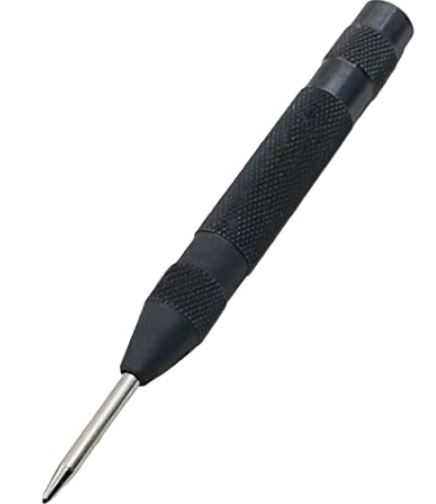
This is by and large similar to the Centre Punch. The main difference is that its point is at a 60° angle. It is used to make permanent the marking done by scribes so that these lines do not obliterate at the time of work. Basically, its length is from 80 mm to 100 mm and its thickness from 3 mm to 5 mm. It has been illustrated in Figure.
#14 Bell Punch
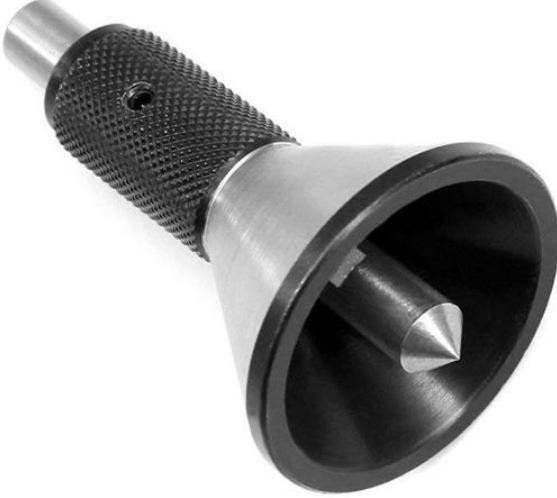
As per its name, it is like a small bell, in shape. Its size is considered according to the circumference of the bell. It is used to find out the center of round jobs and for light marking.
In this circumference, a punch is fixed with the help of a spring, which is like a center punch. For using it, its head is hit with a hammer and because of the punch spring, it raises alone.
#15 Letter Punch
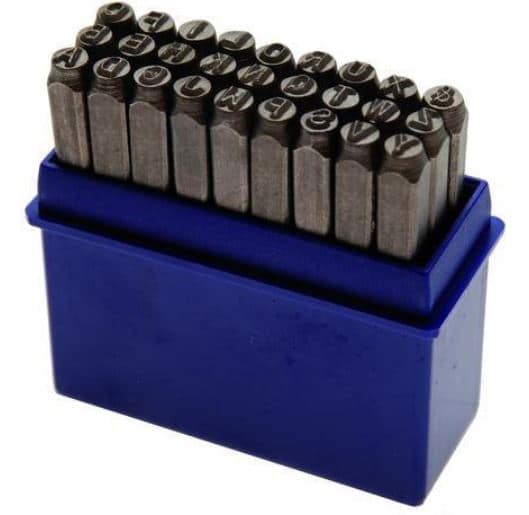
The letter stamps are in the form of a reverse image, making the final result quickly readable, although they can be produced as a positive image. It is also known as a number or letter stamp.
These types of punches are used to convert the print of a letter or number into a workpiece. This is necessary for dye or mold making and ensures that the finished product will be readable.
#16 Tablet Punch
This punch is also known as tablet press. Unlike most punches, tablet press punches have a curved end of the desired tablet shape. This tablet press has lower and upper punches to compress the powder between them.
#17 Automatic Punch
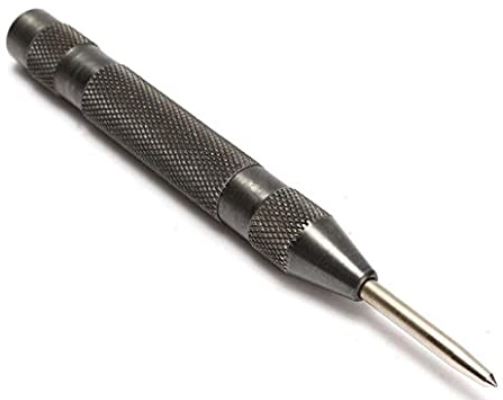
This is also a special kind of punch. It is made of high carbon steel which is hardened or tapered. There is no need for a hammer for using this punch.
The main punch is fitted with its body with a spring. Spring remains settled through a lever head. When marking is to be done, its lever head is pressed. Through this pressure, the main punch would be pressed and do the marking.
The blow of the punch can be limited or controlled with the lever head. Its main punch is built at a 60° or 90° angle. This type of punch has been illustrated in Figure.
Read Also: Differet Types of Clamps & Their Uses [How To Use Guide]
Advantages of Punch Tools
Comparing punch tools to other cutting or drilling techniques reveals several benefits. The following are some benefits of using punch tools:
- Punch tools have high accuracy and can make precise cuts and holes, ensuring consistency and uniformity in the final product.
- Punch tools have a high rate of productivity and efficiency, especially when performing repetitive cutting or punching tasks.
- Punch tools can create holes or cuts that are clear and free of scratches, which eliminates the need for additional finishing processes.
- Punches can be found in a wide range of sizes and shapes, making them appropriate for various materials and uses.
- Punch tools are built to last and are reliable because they are made of high-quality materials and can withstand repeated use.
Disadvantages of Punch Tools
Punch tools have some drawbacks in addition to their many benefits. The following are some possible drawbacks of using punch tools:
- Punch tools may not be appropriate for thicker materials or deep cuts due to their limited cutting depth.
- Punch tools are made specifically for cutting or punching tasks. They might not be appropriate for complex shapes or unique designs.
- Punches require regular maintenance, such as sharpening or replacing worn cutting edges, to ensure optimal performance.
- Operators must take precautions to prevent injury because punch tools can be dangerous if not used correctly.
- Punch tools can be pricey to buy at first, particularly if they are high-quality or specialized tools.
Read Also: 22 Types of Axes & Their Uses [Explained with Pictures]
Precautions of Using Punch
In order to ensure correct and accurate marking with any type of punch, the following precautions should be taken:
- Selection of punch should be made according to the make-up of the job or metal.
- A light hammer should be used for a light punch.
- Do not use an ordinary punch or a hard metal.
- Use a punch after seeing its angle.
- If the point of the punch is damaged, it should be repaired and then the punch should be used.
- Hollow punch should not be used on thick sheets.
Conclusion
By using the punch in your workshop you can create holes in a variety of shapes. Punching is a cost-effective process for making holes in metal workpieces. Now that we know everything about punches but if you have any doubts you can ask in the comments.
I hope you like our article on “types of punches“, if yes then please share with your friends. And subscribe to our newsletter for more article like this
Download the PDF file of this article by clicking below:
Read more in our blog:
- File Tools: Types, Parts, Applications with (PDF)
- What is Reamer Tool? Its Types, and Applications
- What are the Types of Rivets and Riveted Joints? (PDF)
External resources:
Yousef, thanks for your primer on punches. I encourage you to elicit feedback from English speakers/writers on your use of English grammar and diction. That way you will accelerate the growth of your communication skills in this language. I have subscribed so now I may look forward to seeing your improvement. Be well!
Thank you so much for your valuable feedback.